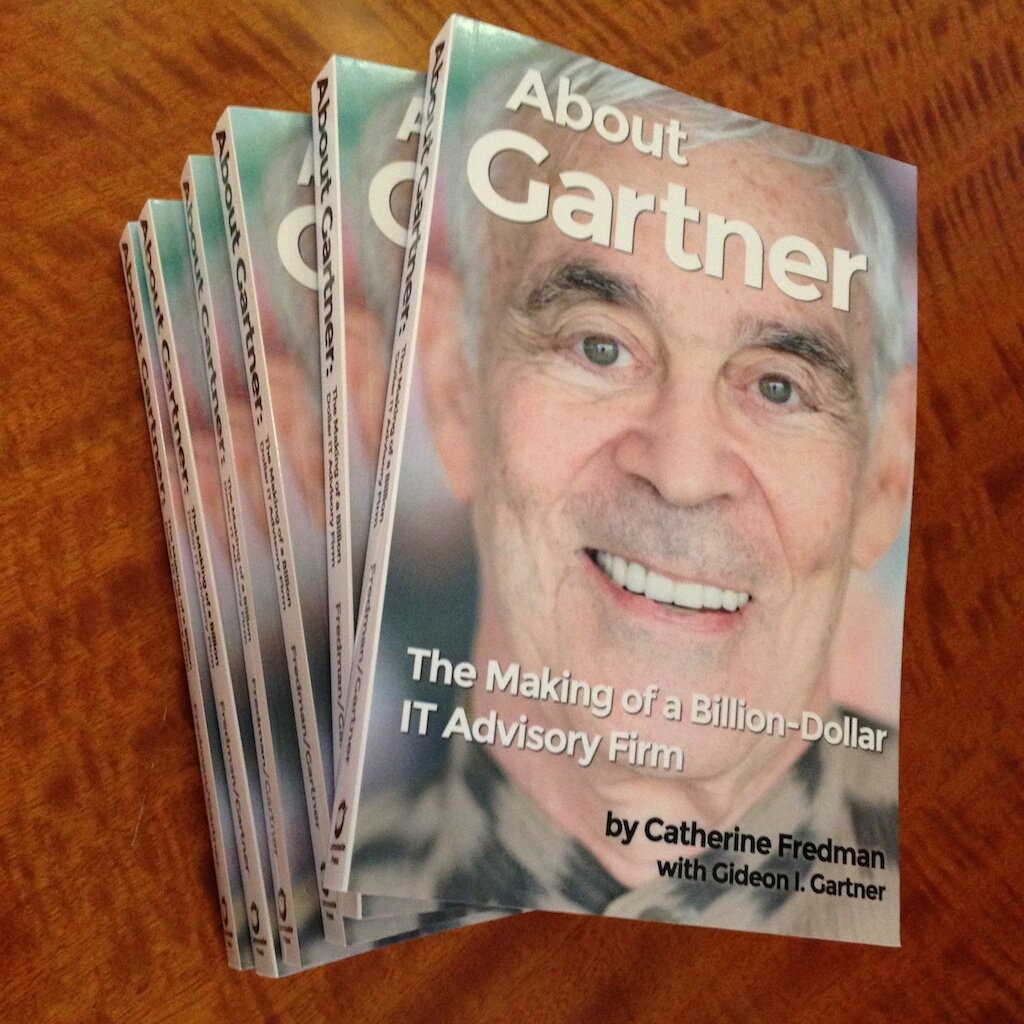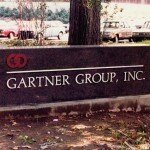Soundview: The early years
 Recall that I spent 9 years on Wall Street as a technology analyst just before Gartner Group (Gartner Inc.) was founded in March 1979. True, our Gartner charter was to sell from the very start into three different markets: IT vendors, users, and institutional investors. But we didn’t raise enough cash to build sales teams in all three markets, so to deal with institutional investors we looked for an independent but appropriate marketing arm with Wall Street credentials. Our board member Chris Brody introduced us to Dillon, Read, which agreed to pay Gartner $500K for a first trial year. We must have been well received by the market because our fee incremented by the same $500K in each of the next five years, to a level of $2.5 million. This was very profitable for us, as our few financial analyst hires (and myself) produced relatively short reports called “Green Sheets”, and were supported by our rapidly growing cadre of Gartner analysts who were usually producing fundamental and valuable analysis for several key technology sectors. Dillon, Read’s sales pitch to institutions was that we had the inside track on technology relating to investment decisions, and frankly it used my name constantly (the financial institutions had all been clients of Oppenheimer, where I had luckily become well known; luck is important in life).
Recall that I spent 9 years on Wall Street as a technology analyst just before Gartner Group (Gartner Inc.) was founded in March 1979. True, our Gartner charter was to sell from the very start into three different markets: IT vendors, users, and institutional investors. But we didn’t raise enough cash to build sales teams in all three markets, so to deal with institutional investors we looked for an independent but appropriate marketing arm with Wall Street credentials. Our board member Chris Brody introduced us to Dillon, Read, which agreed to pay Gartner $500K for a first trial year. We must have been well received by the market because our fee incremented by the same $500K in each of the next five years, to a level of $2.5 million. This was very profitable for us, as our few financial analyst hires (and myself) produced relatively short reports called “Green Sheets”, and were supported by our rapidly growing cadre of Gartner analysts who were usually producing fundamental and valuable analysis for several key technology sectors. Dillon, Read’s sales pitch to institutions was that we had the inside track on technology relating to investment decisions, and frankly it used my name constantly (the financial institutions had all been clients of Oppenheimer, where I had luckily become well known; luck is important in life).
While we kept trying to market through Dillon, Read’s extremely small salesforce, various structural alternatives were considered. But being relatively small, albeit growing, we suffered internal personnel issues. I recall that Tom Crotty, Peter Wright and Fran Saldutti were vying for the leadership role and minor issues appeared almost daily. For example, in early 1985 we found that one of our three leaders had a significant “carried interest” in a different firm which he suggested we invest in, and if we agreed could be worth $480K in our fiscal 1986 (March 31 year) and $800K in our fiscal 1987! Our CFO Grigs Markham who analyzed the proposal replied in writing that such would be “a lousy investment” for Gartner Group, we should let our star walk and we’d recoup his un-vested stock using it to “incentivize others who make a more direct contribution to GG’s mainline business”. I ignored his note and dealt with our senior analyst as best I could at the time (so much for our CFO’s enthusiasm for the Wall Street segment of our business).
Peter Wright, then a difficult to manage star, lobbied that we should do more about improving the net assets of what had been essentially a department, but which could become a substantial Wall Street brokerage to include a full trading department, stronger sales resources, and ultimately entry into money management and even corporate finance. I loved that kind of get-up-and-go and we were already beginning to sell to Venture Capital firms and were tinkering with other opportunities, but we had neither the capital or the manpower at the time to be aggressive, plus my own plate was very full.
When we first considered an initial public offering (IPO) our Gartner board members observed the obvious, that the Wall Street P&L model was so different from the Gartner P&L model (let alone differences in revenue vs. earnings stability) that the potential Gartner IPO investors would not understand us. “Spin out the brokerage business” they first implied, and then said outright. Sure enough, by late 1985 soon before Gartner went public in 1986, Gartner Securities was spun out of Gartner and became a separate company! The equity interests were split somehow, with our venture investors and myself being the largest shareholders.
Note: I’ll call Gartner Securities “Soundview” from this point, even though this later name had not yet been coined!
In choosing a president for the now independent Soundview, while Tom Crotty was much more senior, I deemed Peter to be more creative and energized, thus he was selected. The company had experienced one important loss in 1985 when our star software analyst Scott Smith left us for the major Wall Street research firm Donaldson Lufkin Jenrette (he later founded his own hedge fund). New analysts joined from outside or were transferred from Gartner to Soundview: Jimmy Weil (PC)s, Andy Schopick (Telecom), and Bill Walbert all transferred from Gartner with our blessings. Walbert soon became head of sales, and once told me while still at AT&T but interviewing at Gartner, “I found a land of beautiful people…the women, the men, never did I see a firm where everyone was young, sharp, things happening, much buzz. I had to work at this company”.
The Soundview people now saw the potential of the independent firm becoming an investment bank but with continuing specialization in the country’s most complex industry, IT, and most importantly with the rapidly expanding Gartner Group research behind it.
Here’s the story of Gartner Securities being renamed Soundview: Saatchi & Saatchi purchased Gartner Group Inc. in 1988, and it paid $1.2 million to Gartner Securities to change its name of the now-independent financial business to something not using the name Gartner in order to avoid confusion. After huddling together, we selected the name Soundview Financial Group based upon our location in the Soundview district of Stamford CT. A lighthouse existed near our headquarters on the Long Island Sound, and we agreed to use the lighthouse as our symbol. When I saw an artist’s drawing, I complained to Peter Wright that there was a critical omission in that the lighthouse was not showing a beam of light, which I believed was critical to what a lighthouse was all about! We argued about this vociferously, but I finally capitulated, because after all, Peter was Soundview’s boss. He and I, still close friends, were and are quite different personalities.
In 1990 Peter Wright resigned from the firm and followed in Scott Smith’s footsteps, leaving the firm to form hedge fund PAW Partners (his middle initial was A). Leadership of Soundview was then temporarily shared by the five leaders of its functions, until Jamie Townsend was promoted from sales and became its president in 1991.
I had been chairman of this newly christened spin-out since it was spun out but I participated at board meetings only, due to my heavy demands at Gartner which was now a public company while also growing and diversifying rapidly (a challenging mix). One day in 1992 I received a call from Jamie asking that I sell my shares back to Soundview. Why? Jamie was in the process of contacting all Soundview outside shareholders, virtually demanding that to continue retaining our star producers and to negotiate and convince proven professionals in the Wall Street sales and trading functions to jump ship and join Soundview, the firm absolutely required that we sell our shares back to the firm. He was offering a somewhat higher price than book value as an incentive and most outside shareholders who owned small positions had agreed, and he was now asking those who owned significant pieces of the firm. I understood what he was saying but declined to agree before speaking with our board members who owned shares. Soon after, I learned that there were only two hold-outs, original Gartner investor Chris Brody of Warburg Pincus, and myself. I was being allowed to keep 10% of my position, as there would not have been Soundview if not for me, and I was both the founder and Chairman. After another week or two Jamie called again to say that Chris Brody agreed as well, and I finally capitulated, selling back 90% of my shares and resigning the chairmanship, two possibly poor decisions. But the Soundview employee pool which had owned 49% of the business, would now own 95% with a significant percentage reserved for new hires, and it had a big champagne party to celebrate. Years later, I could not find my share certificates and to this day I’m not sure that I ever received them, and today Jamie actually regrets that I was pushed to sell 90% of my holdings and says that had I taken the firm to court I likely would have prevailed.
Soundview’s analyst lineup continued to gain strength: Steve Cohen whom I had known from IBM World Trade Corporation when we both worked there decades before, properly exploited Gartner Group’s and his own extensive IBM knowledge and reputation (he put out a very notable sell recommendation around 1986); Rick Whittington was a flamboyant analyst in semiconductors; and Chuck Phillips who we had hired from our client Bank of New York as a promising young analyst, who was later seduced by Kidder Peabody to leave us, subsequently joined Morgan Stanley where he became a high-profile software analyst, and eventually became an officer of Oracle Corporation and later its president!
Note: Aside from being somewhat opinionated above, I apologize but cannot be responsible for errors. Please send corrections or additions or differing opinions to . Regarding the length: readers can jump to the final pages for lessons learned, and arguable management implications. I’d like to thank Arnie Berman, Bill Walbert , Jamie Townsend, and Peter Wright for filling me in on Soundview’s later years.







69 Comments